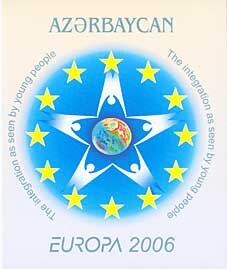Booklet: EUROPA Integration (Azerbaijan 2006)
EUROPA Integration (Azerbaijan 2006)
01 March (Azerbaijan ) within release Europa (C.E.P.T.) 2006 - Integration goes into circulation Booklet EUROPA Integration face value 320 Azerbaijani qəpik
| Booklet EUROPA Integration in catalogues | |
|---|---|
| Michel: | Mi: AZ 638D-639DMH |
Booklet is square format.
Also in the issue Europa (C.E.P.T.) 2006 - Integration:
- Mini Sheet - EUROPA Integration M/S II face value 6;
- Mini Sheet - EUROPA Integration M/S I face value 2;
- Stamp - National symbols face value 20;
- Stamp - National symbols face value 60;
- Booklet - EUROPA Integration face value 320;
- Stamp - National Symbols face value 20;
- Stamp - National Symbols face value 60;
Booklet EUROPA Integration it reflects the thematic directions:
Anti-racism encompasses a range of ideas and political actions which are meant to counter racial prejudice, systemic racism, and the oppression of specific racial groups. Anti-racism is usually structured around conscious efforts and deliberate actions which are intended to create equal opportunities for all people on both an individual and a systemic level. As a philosophy, it can be engaged in by the acknowledgment of personal privileges, confronting acts as well as systems of racial discrimination and/or working to change personal racial biases. Major contemporary anti-racism efforts include the Black Lives Matter (BLM) movement and workplace anti-racism
A culture is a way of life of a group of people--the behaviors, beliefs, values, and symbols that they accept, generally without thinking about them, and that are passed along by communication and imitation from one generation to the next. Culture is symbolic communication. --the behaviors, beliefs, values, and symbols that they accept, generally without thinking about them, and that are passed along by communication and imitation from one generation to the next. Culture is symbolic communication.
A star is a luminous spheroid of plasma held together by self-gravity. The nearest star to Earth is the Sun. Many other stars are visible to the naked eye at night; their immense distances from Earth make them appear as fixed points of light. The most prominent stars have been categorised into constellations and asterisms, and many of the brightest stars have proper names. Astronomers have assembled star catalogues that identify the known stars and provide standardized stellar designations. The observable universe contains an estimated 1022 to 1024 stars. Only about 4,000 of these stars are visible to the naked eye—all within the Milky Way galaxy.



